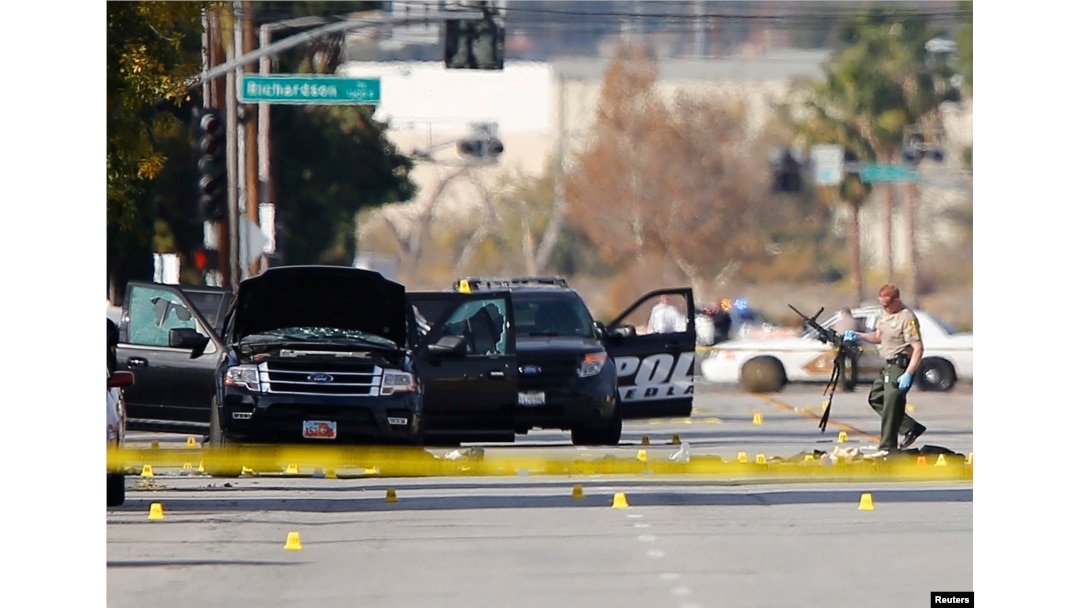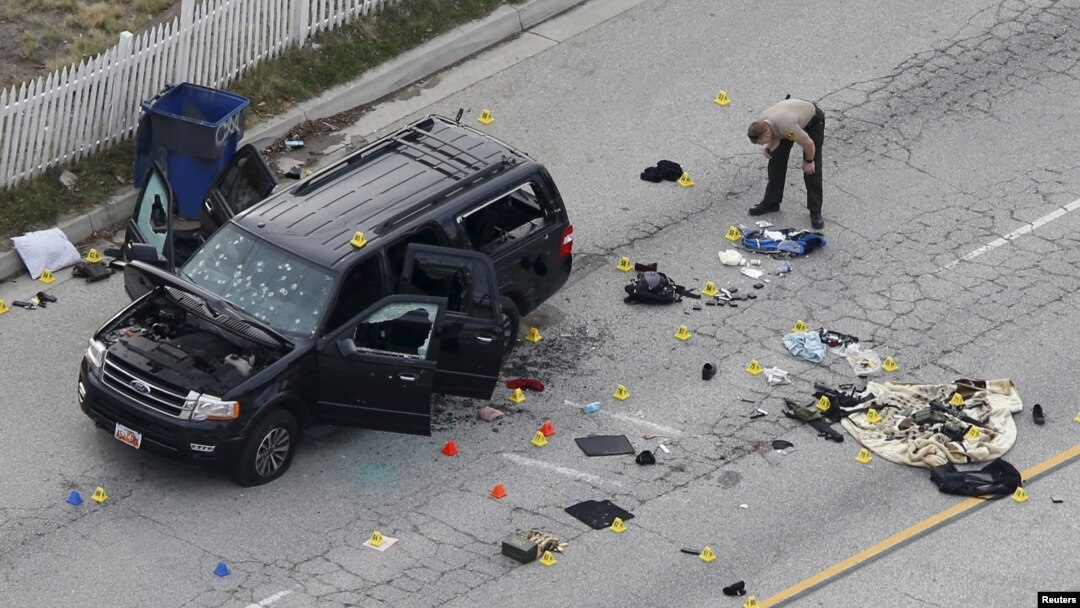Links between the Islamic State group and Tashfeen Malik, which the Pakistani native confirmed just before she and her husband opened fire with automatic rifles and slaughtered 14 people in California on Wednesday, have greatly expanded concerns about foreign terrorists' influence on American soil.
Malik, 29, and her American-born husband, Syed Rizwan Farook, 28, are now the principal focus of an enormous effort by U.S. authorities to discover what motivated or inspired the couple to plan and carry out the attacks, which primarily targeted Farook's co-workers in California's San Bernardino County, east of Los Angeles.
Malik and Farook fled the bloodbath and were at large for several hours Wednesday, until they tried to shoot their way out of a police cordon and died in a volley of hundreds of bullets.
Before that bloody ending, however, a message apparently posted by Malik appeared on Facebook in which she pledged allegiance to the Islamic State terror group, and specifically to its leader, Abu Bakr al-Baghdadi, in Syria.

FILE - A police officer picks up a weapon from the scene of the investigation around the area of the SUV vehicle where two suspects were shot by police following a mass shooting in San Bernardino, California, Dec. 3, 2015.
The post was removed a day later, but messages circulated by Islamic State Saturday claimed Malik and Farook as "soldiers" and "supporters" of the extremist group. IS online radio broadcasts described them as "martyrs."
Terror claims
The Federal Bureau of Investigation's David Bowdich, in charge of that agency's Los Angeles office, appeared before reporters late Friday and announced: "We are now investigating these horrific acts as an act of terrorism."
Bowdich and other law-enforcement officials in California have steered clear of specifically tying Malik and Farook's actions to Islamic extremism. But many investigators and experts who study extremist groups suspect Islamic State's claims about the California couple may be borne out.
FILE - Federal Bureau of Investigation assistant director David Bowdich speaks during a news conference in San Bernardino, Calif., Dec. 4, 2015.
The San Bernardino shootings could be seen as the worst assault on the United States by Islamic extremists since the multiple attacks on New York and Washington by al-Qaida-sponsored terrorists on September 11, 2001.
Nearly 3,000 people died then – in New York at the site of former World Trade Center, at the Pentagon outside Washington, D.C., and at a rural site in Pennsylvania. Hijacked commercial airliners crashed at each location.
Since the Islamic State group became a fierce and notoriously brutal force in recent years in Iraq and Syria, it has called repeatedly on its followers to stage violent attacks against the United States as well as U.S. coalition partners in Europe and the Gulf.
Whether Islamic State inspired or directed the attack, "there’s value for ISIS to claim it either way," the director of transnational threats at the Washington-based Center for Strategic and International Studies said, using another acronym for the group.
An undated combination of California Department of Motor Vehicles photos shows Tashfeen Malik, left, and Syed Farook, the husband and wife who died in a gunbattle with authorities after a mass shooting in San Bernardino, Calif., Dec. 2, 2015.
A claim lends credibility to the call to battle, Thomas Sanderson explained.
"It strikes fear in the hearts of Americans," he said. "I think it makes Americans feel to some degree uniformly vulnerable because this was a strike at an office and not a strike on a financial center or a strike on the Pentagon or the FBI headquarters."
A confirmed link between IS and one or both assailants would also expand "the spectrum of attack techniques," he added.
Assailants’ demographics
Seamus Hughes, co-author of a new report, “ISIS in America,” was not surprised by Malik's role in the California bloodbath.
Women have been active in various terrorist groups and, "in terms of ISIS, they've played various roles as radicalizers and recruits and propagandists," said Hughes, deputy director of The George Washington University’s program on extremism.
The new study on terrorist infiltration found up to 300 Americans or U.S.-based people sympathetic to the Islamic State group who are active on social media. A third of them are women.
FILE - Women and children attend the Ahmadiyya Muslim Community USA members prayer vigil for the victims of Wednesday's massacre at the San Bernardino's Baitul Hameed Mosque in Chino, Calif., Dec. 3, 2015.
Hughes said there is no "typical profile when it comes to ISIS recruits," but he found a husband-and-wife attack team notable: "In terms of the couple, that is a unique dynamic."
It is not clear whether whether Malik or Farook first became radicalized, or when and where. The couple deleted computer files and smashed cellphones to slow investigators’ search for clues and connections.
They reportedly met first online. Malik was living in Saudi Arabia; Farook visited there and Pakistan last year, returning with Malik, who was granted a U.S. visa as his fiancée. Neither was on a watch list, according to authorities.
The couple married in the United States and had a baby daughter about six months ago.
WATCH: Related video of suspects' family attorney news conference
Your browser doesn’t support HTML5
Attorney for San Bernardino Shooters' Family Holds Press Conference
Sanderson speculated Farook "may have decided to marry someone so that he would look less suspicious.... This is a guy who grew up in America. He may have thought that, with a wife and a child, he may not attract … attention."
Or Malik may have taken the lead.
"Every radicalization process is different. That’s what makes it so difficult to identify," said Colin Clarke, a RAND Corp. researcher who focuses on insurgency and counterinsurgency. "There’s no one single prototype that individuals follow. So there probably were signs that could have been picked up by people who knew" them.
Immigration
Malik entered the United States on a fiancée visa, which may ratchet up already-heightened interest in how newcomers are screened.
The coordinated November 13 terrorist attacks in Paris focused attention on refugee resettlement and, more recently, on visa waivers. The White House this week announced tighter screening for the latter program, used by about 20 million visitors to the United States each year.
FILE - News media look at documents left inside the home of suspects Syed Rizwan Farook and Tashfeen Malik in Redlands, California, following Wednesday's attacks, Dec. 4, 2015.
To get a U.S. fiancée visa, or K-1 nonimmigrant visa, requires rigorous screening, says Palma Yanni, a past president of the American Immigration Lawyers Association.
Applicants face a battery of security hurdles, including repeated biometric and biographic testing, international checks for financial and criminal records, and interviews at a U.S. consulate, Yanni said. "The goal is a five-month processing time, but frequently [it’s] been longer than that."
Yanni pointed out applicants must marry within 90 days of entering the United States and must file another set of papers to confirm they married.
"Knowing how many security checks are done, what more can we do, administer truth serum?" she wondered. "… I hope there’s no change in policy based on a Facebook posting."


